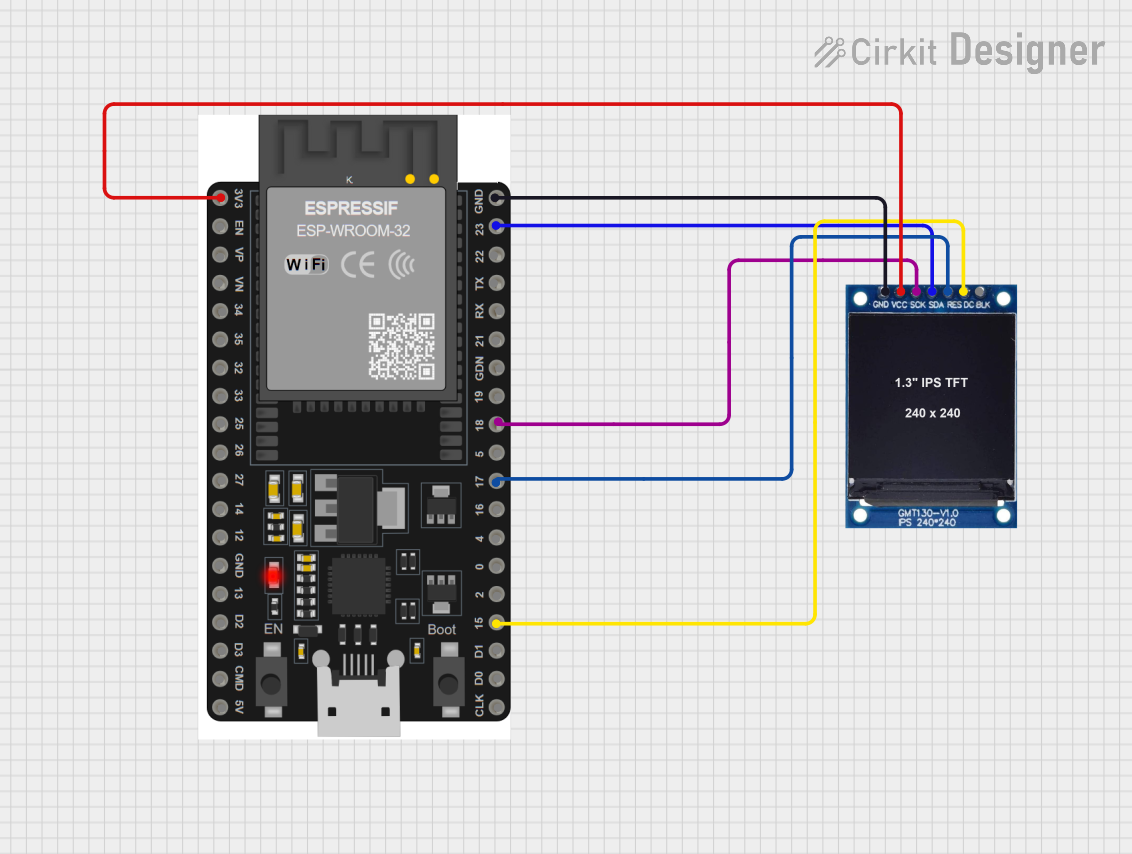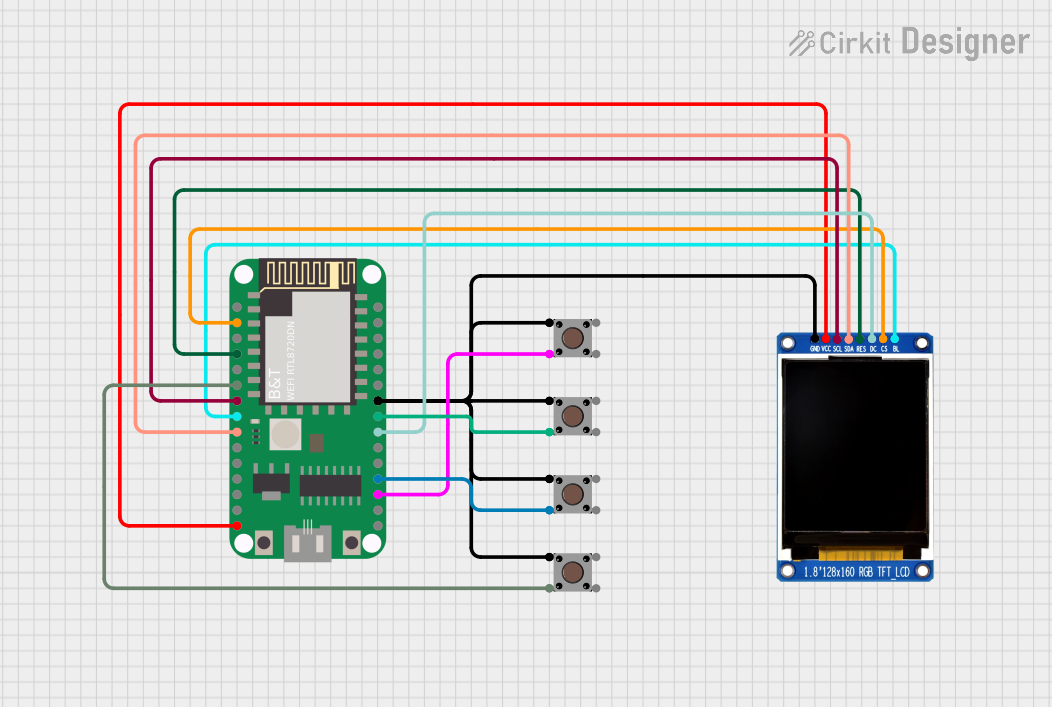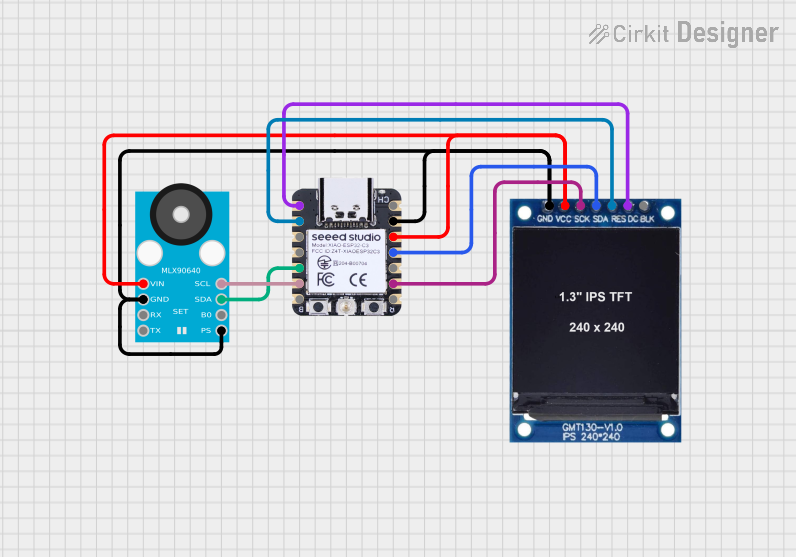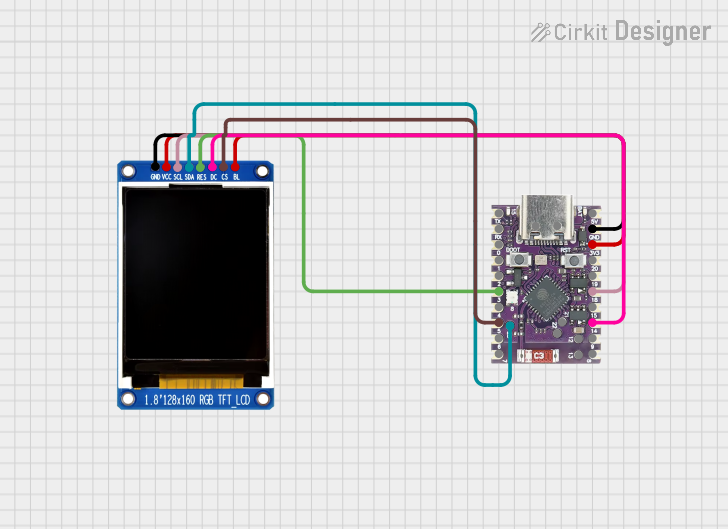
How to Use TFT 1.69" 240x280 ST7789V3: Examples, Pinouts, and Specs

 Design with TFT 1.69" 240x280 ST7789V3 in Cirkit Designer
Design with TFT 1.69" 240x280 ST7789V3 in Cirkit DesignerIntroduction
The TFT 1.69" 240x280 ST7789V3 is a compact, high-resolution thin-film transistor (TFT) display module. It features a resolution of 240x280 pixels and utilizes the ST7789V3 driver, which ensures vibrant color output and fast refresh rates. This display is ideal for applications requiring a small, high-quality screen, such as smartwatches, handheld devices, IoT projects, and embedded systems.
Explore Projects Built with TFT 1.69" 240x280 ST7789V3

 Open Project in Cirkit Designer
Open Project in Cirkit Designer
 Open Project in Cirkit Designer
Open Project in Cirkit Designer
 Open Project in Cirkit Designer
Open Project in Cirkit Designer
 Open Project in Cirkit Designer
Open Project in Cirkit DesignerExplore Projects Built with TFT 1.69" 240x280 ST7789V3

 Open Project in Cirkit Designer
Open Project in Cirkit Designer
 Open Project in Cirkit Designer
Open Project in Cirkit Designer
 Open Project in Cirkit Designer
Open Project in Cirkit Designer
 Open Project in Cirkit Designer
Open Project in Cirkit DesignerCommon Applications
- Smartwatches and wearable devices
- Portable medical equipment
- IoT dashboards and control panels
- Embedded systems requiring graphical interfaces
- DIY electronics and hobbyist projects
Technical Specifications
Key Details
| Parameter | Specification |
|---|---|
| Display Type | TFT (Thin-Film Transistor) |
| Resolution | 240x280 pixels |
| Driver IC | ST7789V3 |
| Display Size | 1.69 inches (diagonal) |
| Interface | SPI (Serial Peripheral Interface) |
| Operating Voltage | 3.3V |
| Backlight Voltage | 3.0V to 3.3V |
| Current Consumption | ~20mA (typical, backlight on) |
| Color Depth | 65K (16-bit RGB) |
| Viewing Angle | 160° |
| Operating Temperature | -20°C to 70°C |
Pin Configuration
The TFT 1.69" 240x280 ST7789V3 module typically has an 8-pin interface. Below is the pinout description:
| Pin Number | Pin Name | Description |
|---|---|---|
| 1 | GND | Ground (0V reference) |
| 2 | VCC | Power supply (3.3V) |
| 3 | SCL | Serial Clock (SPI clock input) |
| 4 | SDA | Serial Data (SPI data input) |
| 5 | RES | Reset pin (active low) |
| 6 | DC | Data/Command control pin |
| 7 | BLK | Backlight control (connect to 3.3V for always on) |
| 8 | CS | Chip Select (active low) |
Usage Instructions
Connecting the Display
To use the TFT 1.69" 240x280 ST7789V3 with a microcontroller (e.g., Arduino UNO), follow these steps:
- Power Supply: Connect the
VCCpin to a 3.3V power source and theGNDpin to ground. - SPI Interface: Connect the
SCL(clock) andSDA(data) pins to the corresponding SPI pins on the microcontroller. - Control Pins:
- Connect the
RESpin to a GPIO pin for resetting the display. - Connect the
DCpin to a GPIO pin to toggle between data and command modes. - Connect the
CSpin to a GPIO pin to enable/disable the display.
- Connect the
- Backlight: Connect the
BLKpin to 3.3V for constant backlight or to a PWM pin for brightness control.
Example Code for Arduino UNO
Below is an example of how to use the TFT 1.69" 240x280 ST7789V3 with an Arduino UNO. This code uses the Adafruit ST7789 library.
#include <Adafruit_GFX.h> // Core graphics library
#include <Adafruit_ST7789.h> // ST7789 driver library
#include <SPI.h> // SPI library
// Define pin connections
#define TFT_CS 10 // Chip Select pin
#define TFT_RST 9 // Reset pin
#define TFT_DC 8 // Data/Command pin
// Initialize the display object
Adafruit_ST7789 tft = Adafruit_ST7789(TFT_CS, TFT_DC, TFT_RST);
void setup() {
// Initialize serial communication for debugging
Serial.begin(9600);
Serial.println("TFT 1.69\" 240x280 ST7789V3 Test");
// Initialize the display
tft.init(240, 280); // Initialize with resolution 240x280
tft.setRotation(1); // Set display orientation (0-3)
// Fill the screen with a color
tft.fillScreen(ST77XX_BLACK);
tft.setTextColor(ST77XX_WHITE);
tft.setTextSize(2);
tft.setCursor(10, 10);
tft.println("Hello, World!");
}
void loop() {
// Example: Draw a red rectangle
tft.fillRect(50, 50, 100, 100, ST77XX_RED);
delay(1000);
// Example: Clear the rectangle
tft.fillRect(50, 50, 100, 100, ST77XX_BLACK);
delay(1000);
}
Important Considerations
- Voltage Levels: Ensure the display operates at 3.3V. If using a 5V microcontroller, use level shifters for the SPI and control pins.
- Backlight Control: For adjustable brightness, connect the
BLKpin to a PWM-capable GPIO pin. - Library Compatibility: Use the Adafruit ST7789 library for easy integration and access to graphics functions.
Troubleshooting and FAQs
Common Issues
No Display Output:
- Verify all connections, especially power (VCC and GND).
- Ensure the
CS,DC, andRESpins are correctly connected and configured in the code. - Check if the SPI clock and data pins match the microcontroller's SPI pins.
Flickering or Distorted Display:
- Ensure the SPI clock speed is within the display's supported range.
- Check for loose or poor-quality connections.
Backlight Not Turning On:
- Confirm the
BLKpin is connected to 3.3V or a PWM pin. - Measure the voltage at the
BLKpin to ensure it is receiving power.
- Confirm the
Incorrect Colors or Orientation:
- Use the
setRotation()function to adjust the display orientation. - Verify the color format (16-bit RGB) is correctly implemented in the code.
- Use the
Tips for Troubleshooting
- Use a multimeter to check voltage levels at the
VCCandBLKpins. - Test the SPI communication using a logic analyzer if the display does not respond.
- Refer to the ST7789V3 datasheet for advanced debugging and configuration options.
By following this documentation, you can successfully integrate and use the TFT 1.69" 240x280 ST7789V3 display in your projects.